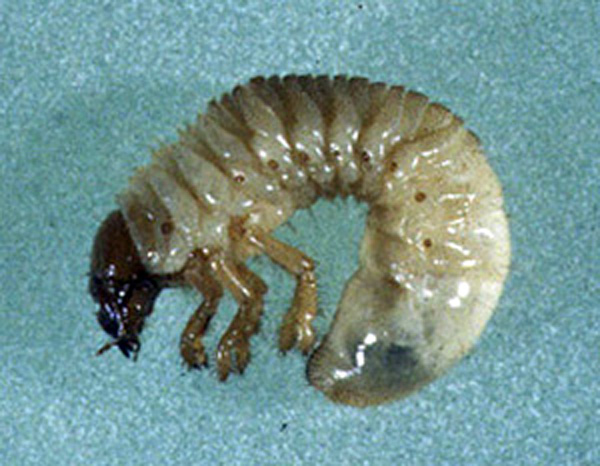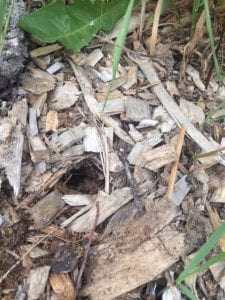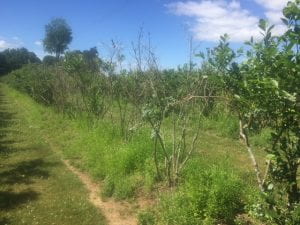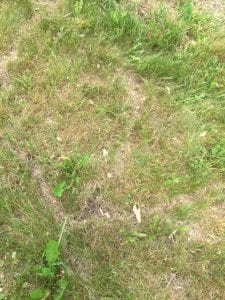Decline in plant vigor without visible above-ground plant symptoms can difficult to diagnose. There are many possible causes when root symptoms are present, including nematodes, white grubs, voles, and mealybugs. (Nematodes and grubs are more likely in lighter soils while voles prefer heavy mulch and grassy alleyways.) When roots appear healthy, the problem could be viral or associated with nutrient deficiency, soil type or soil compaction.
Root symptoms present
- Feeder roots have lesions or galls
- Roots appear stubby, chewed. White grubs are present in soil around roots
- Large lateral roots are chewed or gnawed. Surface runways are present in mulch or grass row middles; tunnel entrance holes are about one inch in diameter
- Roots are covered with white cottony insects. Ant colonies are present.
Root symptoms absent
Feeder roots have lesions or galls.
Feeding by Dagger or Root Lesion Nematodes may stunt growth of young blueberry plants. Look for small black lesions or galls on feeder roots. Nematode damage to established plants is more likely to occur from transmission of blueberry viruses than direct feeding. Because most soil nematodes are microscopic in size, special laboratory procedures are needed to confirm their presence in soil and/or roots. More information on nematode testing, biology and management.
Roots appear stubby, chewed. White grubs are present in soil around roots.
Feeding by White Grubs. White grubs are larvae of a complex of several types of beetles including Japanese, Asiatic Garden, May, and Oriental beetles and Rose, European, and Northern Masked Chafers, among others. The C-shaped larvae are generally white or cream colored with brown heads and legs. Grubs consume feeder roots, and may clip or girdle larger roots. Populations have been observed to reach as high as 30 grubs per bush. Adult insects such as Japanese beetles and Rose Chafers may also cause leaf and fruit damage.

Large lateral roots are chewed or gnawed.
Feeding by Voles (small, mouse-like rodents) will cause a general decline in blueberry plant health. Meadow (Microtus pennsylvannicus) and Pine (Microtus pinetorum) Voles are the most common voles found in NY State. Vole damage commonly occurs from late fall to early spring when other food sources are limited. Surface tunnels in mulch or grass row middles with a 1 inch diameter entrance hole are an indication of vole activity. Dig up plants and examine the roots for feeding damage. More rodent damage information.




Roots are covered with white cottony insects. Ant colonies are present.
Feeding by the Blueberry Mealybug (Dysmicoccus vaccini). The presence of ants or ant colonies around the root system is usually an indication that mealybugs are present on blueberry roots. Mealybugs appear as small (1-2mm) white soft bodied insects clinging to root tissue. More blueberry mealybug information.
The Smaller Yellow Ant, Acanthomyops claviger, is commonly found associated with blueberries. These ants have a symbiotic relationship with the blueberry mealybug. The ants “farm” the mealybugs for the nutrient rich honeydew they excrete which is a food source for the ants. The ants don’t harm the blueberry plants directly but move the mealybugs from plant to plant to establish new “farms”.
Roots appear healthy. No above ground symptoms are apparent.
The cause of decline in vigor without visible above ground or root symptoms is very difficult to diagnose. Many possible causes exist, most of which will lead to visible symptoms over time. Some of the more common are:
- Virus Infection:
Viruses occur mainly in older plantings, or in plantings where clean nursery stock was not used. Special tests are required to diagnose the presence of virus, and these tests produce many false negatives. Symptoms usually appear only after infections are severe. More information on blueberry viruses.
- Nutrient Deficiency.
Blueberries do not grow well if the soil pH is below 4.0 or above 5.2, or if certain nutrients are deficient as they frequently are in acid soils. Soil and/or foliar analysis done through Agro-One can be used to identify if a nutrient(s) is deficient or if the soil pH is within the recommended range.
- Soil Type and Compaction.
The use of heavy equipment in the field can slowly compact certain soils, leading to a decline in plant vigor. Clean cultivated fields are most vulnerable. Blueberries do not grow well in clayey soils, wet soils, or those high in lime (calcium content).


